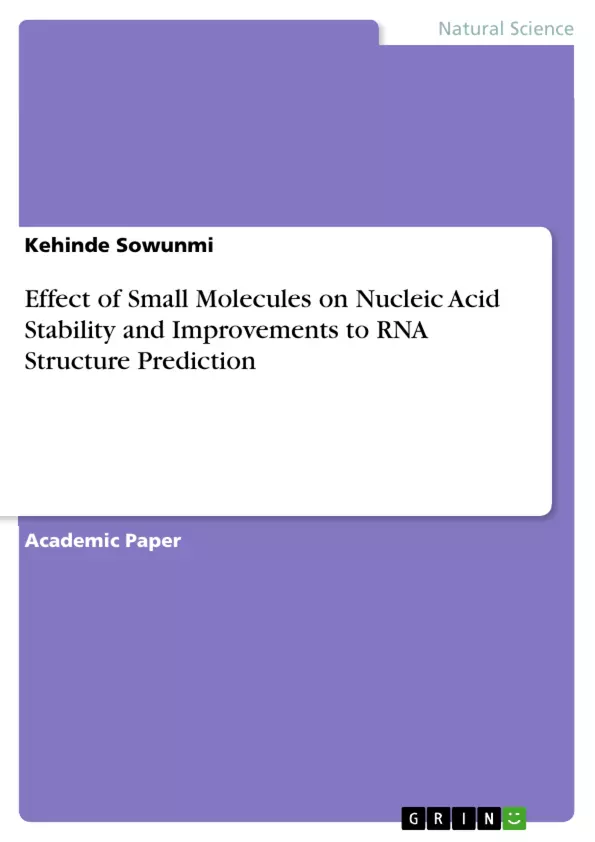Nucleic acids have proven to be viable targets for small molecule drugs. While many examples of such drugs are detailed in the literature, only a select few have found practical use in a clinical setting. These currently employed nucleic acid targeting therapies suffer from either debilitating off-target side effects or succumb to a resistance mechanism of the target. The need for new small molecules that target nucleic acids is evident.
However, designing a novel drug to bind to DNA or RNA requires a detailed understanding of exactly what binding environments each nucleic acid presents. In an effort to broaden this knowledge, the work presented in this thesis details the binding location and affinity of known and novel nucleic acid binding small molecules with targets ranging from simple RNA secondary structure all the way to the complex structure of ribosomal RNA. Specifically, it is shown that the anthracycline classes of antineoplastics prefer to bind at or near mismatch base pairs in both physiologically relevant iron responsive element RNA hairpin constructs as well as DNA hairpin constructs presenting mismatched base pairs.
Also characterized in this thesis is a novel class of topoisomerase II / histone deacetylase inhibitor conjugates that display a unique affinity for DNA over RNA. Finally, the novel class of macrolide-peptide conjugates, known as peptolides, is shown to retain potent translation inhibition of the prokaryotic ribosome and identification of a novel binding site for the anthracycline class of drugs and the characterization of the two novel drug designs presented in this thesis will undoubtedly aid in the effort to design and discover new molecules that aim for nucleic acid targets.
Inhaltsverzeichnis (Table of Contents)
- Introduction
- RNA Structural Motifs Involved in Binding
- Targeting the Ribosome
- References
Zielsetzung und Themenschwerpunkte (Objectives and Key Themes)
This thesis explores the interaction of small molecules with nucleic acids, focusing on understanding their binding mechanisms and potential therapeutic applications. It aims to provide insights into the design and discovery of novel drugs targeting nucleic acids.
- Investigating the binding locations and affinities of small molecules to various nucleic acid structures, including RNA secondary structures and complex ribosomal RNA.
- Analyzing the binding preferences of anthracycline drugs for mismatch base pairs in RNA and DNA hairpins.
- Characterizing a novel class of topoisomerase II/histone deacetylase inhibitor conjugates that display specific affinity for DNA over RNA.
- Exploring the translation inhibition properties of peptolides, a novel class of macrolide-peptide conjugates.
- Identifying novel binding sites for anthracycline drugs and characterizing the two novel drug designs presented in this thesis.
Zusammenfassung der Kapitel (Chapter Summaries)
- Introduction: This chapter provides a broad overview of the role of nucleic acids in gene regulation and the challenges associated with targeting them with small molecules. It highlights the limitations of existing nucleic acid-targeting drugs and emphasizes the need for new therapeutic approaches.
- RNA Structural Motifs Involved in Binding: This chapter delves into the structural features of DNA and RNA, explaining how their unique properties influence the binding of small molecules. It discusses the importance of secondary and tertiary structures and provides examples of drug-nucleic acid interactions, including the binding of daunorubicin to B-DNA.
Schlüsselwörter (Keywords)
The primary focus of this work lies on the interaction of small molecules with nucleic acids, particularly messenger RNA (mRNA), DNA, and ribosomal RNA (rRNA). The key themes include the exploration of binding mechanisms, the identification of novel binding sites, and the characterization of new drug designs targeting nucleic acids.
- Arbeit zitieren
- Kehinde Sowunmi (Autor:in), 2020, Effect of Small Molecules on Nucleic Acid Stability and Improvements to RNA Structure Prediction, München, GRIN Verlag, https://www.hausarbeiten.de/document/594009


